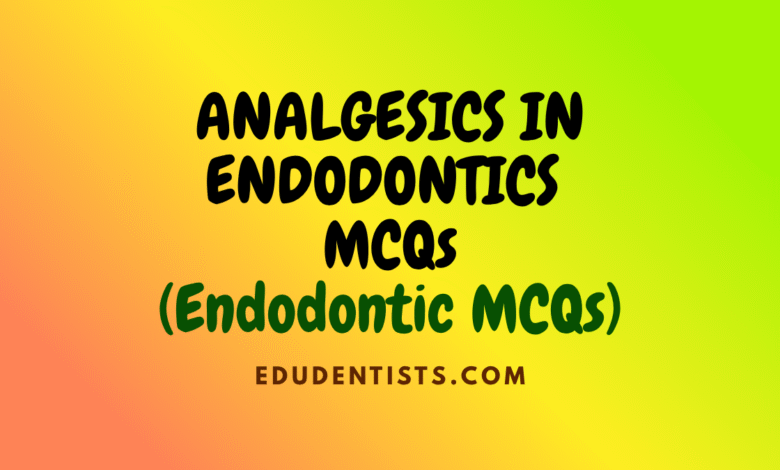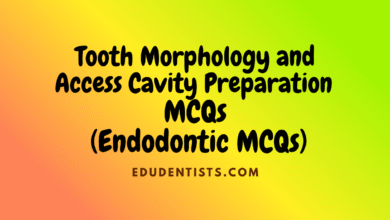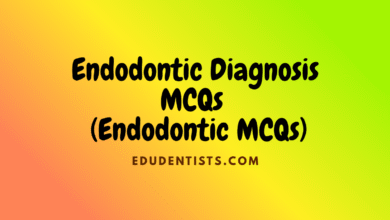ANALGESICS IN ENDODONTICS (ENDODONTICS MCQs)

ANALGESICS IN ENDODONTICS _ ENDODONTICS MCQs
1. Odontogenic pain usually is caused by which of the following
A) Noxious physical stimuli
B) Release of inflammatory mediators
C) Stimulation of sympathetic fibers in the pulp
D) Edema in a ridged, noncompliant root canal system
2. Prostaglandins are related to pain production in that when released, theyA) Directly stimulate free nerve endings
B) Increase the release of mediators of vasodilation
C) Sensitize peripheral nociceptors
D) Reduce the responsiveness of sodium channels on sensory nerves
3. Nociceptive signals are transmitted primarily to which of the following
A) Subnucleus caudalis
B) Limbic system
C) Reticular system
D) Superior cervical ganglion
4. Pain that is referred from an inflamed maxillary sinus to maxillary molars is likely to the phenomenon of which of the following
A) Convergence
B) Sublimation
C) Nociception
D) Information transfer
E) Projection
5. Which of the following statements about descending fibers is true:
A) They are not affected by endogenous opioid peptides.
B) They inhibit transmission of nociceptive information.
C) They transmit information from the cerebral cortex to the thalamus.
D) They are sympathetic fibers that modulate blood flow in the pulp after sensory stimulation.
6. All of the following are characteristics of hyperalgesia except one. Which is the exception:
A) Hyperalgesia is primarily a central mechanism.
B) Spontaneous pain is present.
C) The pain threshold is lowered.
D) Hyperalgesia results in an increased pain perception with noxious stimuli.
7. Which of the following statements about etodolac (Lodine) is correct
A) It causes minimal gastrointestinal irritation compared with ibuprofen.
B) It has a more profound analgesic action than ibuprofen.
C) Studies indicate that etodolac is unique, because it does not have a peripheral analgesic mechanism of action.
D) It has a more significant antiinflammatory effect than ibuprofen.
8. Which of the following statements about activation of opiate receptors is accurate:
A) It blocks nociceptive signals from the trigeminal nucleus to higher brain centers.
B) Opiate receptors are activated peripherally.
C) It induces the release of endorphins.
D) A and B
E) A and C
9. Opioids are frequently used in combination with other drugs because:
A) When nonsteroidal anti-inflammatory drugs (NSAIDs) are used with an opioid, the two act
synergistically on the opiate receptor.
B) The combination permits a lower dose of the opioid, resulting in fewer or diminished side effects.
C) Opioids do not act peripherally.
D) Opioids are not antipyretic.
10. Which of the following statements is true with regard to the use of codeine as an analgesic agent:
A) Codeine prescribed in 60 mg doses is more effective than 650 mg of aspirin.
B) Codeine prescribed in 30 mg doses is more effective than 600 mg of acetaminophen.
C) Codeine prescribed in 30 mg doses is more effective than a placebo.
D) Codeine prescribed in 60 mg doses is more effective than a placebo.
11. Management of pain of endodontic origin should focus on which of the following
A) Removing the peripheral mechanism of hyperalgesia
B) Providing an adequate level of a nonsteroidal, antiinflammatory analgesic agent
C) Prescribing an appropriate antibiotic when pain is the result of infection
D) Using long-acting, local anesthetics to break the pain cycle
12. Which of the following best describes a flexible plan for prescribing analgesic agents:
A) A maximal dose of an opioid is administered. If pain persists, the opioid is supplemented with an NSAID or acetaminophen. Doses are then alternated.
B) A maximal dose of an NSAID or acetaminophen is administered. If pain persists, the NSAID is supplemented with acetaminophen; acetaminophen is supplemented with an opioid.
C) Patients are advised to take the maximal dose of an NSAID a day before the appointment and then as necessary for postoperative pain.
D) Patients are advised to take an opioid agent a day before the appointment and then as necessary for postoperative pain.
13. Administration of an NSAID in combination with cyclosporine may result in which of the following
A) A higher risk of nephrotoxicity:
B) Bone marrow suppression.
C) A decrease in the activity of cyclosporine
D) Higher concentrations of the NSAID in blood plasma
14. Administration of an NSAID in combination with an anticoagulant may result in which of the following:
A) Increased prothrombin time
B) Decreased bleeding time
C) Increased bioavailability of the anticoagulant
D) No adverse effect
15. The patients perception of pain with irreversible pulpitis is primarily at the:
A) Level of the spinothalamic tract
B) Thalamic level
C) Peripheral nociceptive C fibers
D) Cortical level
16. Peripheral afferent nerve fibers in an inflamed pulp may respond to mediators by:
A) Reducing the concentration of those mediators
B) Reducing responsiveness to nociceptive stimuli
C) Reducing the number of anesthetic molecule receptors
D) Reducing the number of ion channels
E) Sprouting of terminal fibers
17. An orally administered drug that has shown anxiolytic properties in dental patients is:
A) Codeine
B) Triazolam
C) Tramado l
D) Oxycodone in combination with acetaminophen
18. To minimize posttreatment pain, analgesics are most effective when administered
A) As a pretreatment
B) Immediately after treatment
C) When the anesthetic begins to wear off
D) When the patient first perceives pain
E) When the pain is the most intense
19. Prophylactic administration of antibiotics to control adverse posttreatment symptoms in prospective, controlled clinical trials on asymptomatic patients has been shown to be:
A) Ineffective
B) Effective if the antibiotic is given in high doses
C) Effective only if the antibiotic is given as pretreatment
D) Effective if the antibiotic is given in conjunction with intracanal antibiotics
20. Cyclooxygenase-2 (COX-2) inhibitors currently are not recommended for treatment of routine endodontic pain because they are:
A) Less effective for pain control than other NSAIDs
B) Associated with frequent gastrointestinal irritation
C) Poorly absorbed from the gastrointestinal tract and do not reach therapeutic blood levels
D) Associated with an increased risk for prothrombic events





